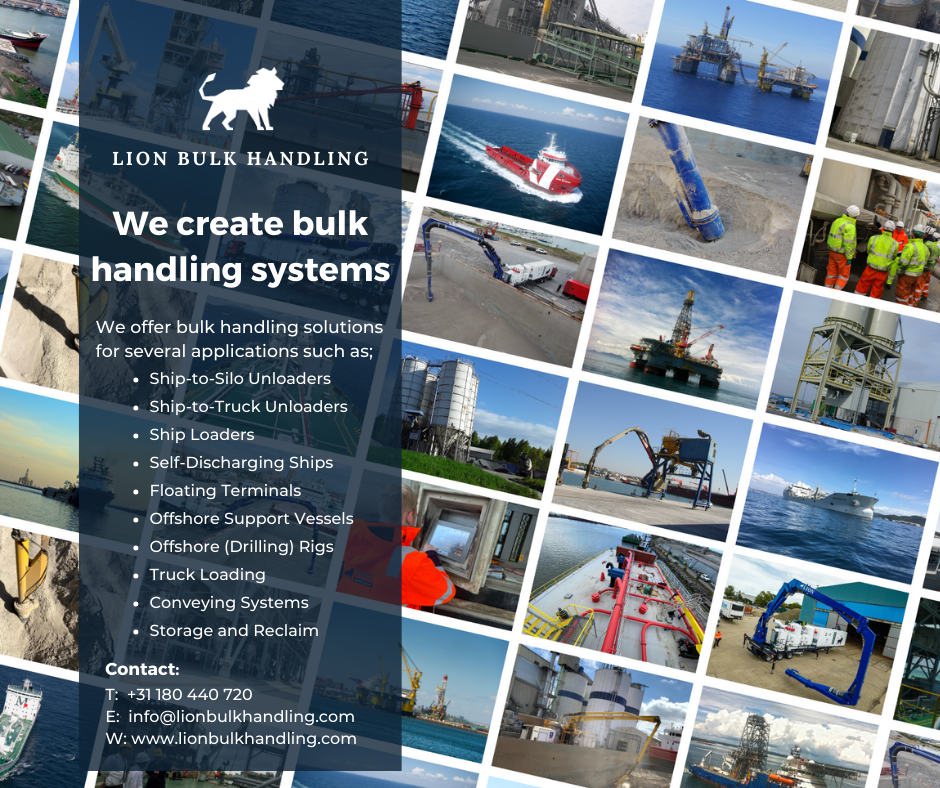Energy Efficient Systems on board of Self-Discharging Cement Carriers

Climate protection as the only argument does not seem sufficient for the partly highly expensive investment in energy efficient technologies. But due to increasing energy costs, energy efficient equipment gets more and more attractive. Especially the bulk materials handling industry still has an enormous potential to save energy and costs. The topic of energy efficiency is very popular today, therefore we wrote this blog post.
Cost Savings by efficient use of energy
The climate protection as only argument does not seem sufficient for the partly highly expensive investment in energy efficient technologies. The companies have to sustain themselves in a hard global competition and to operate successfully anyway. But in this context, increasing energy costs lead to rethinking and energy efficient equipment becomes more attractive. Although the price for crude oil, natural gas and industrial power, has decreased in the last year, when the maximum price was reached, experts predict a continuing rising tendency for a long-term period.
Efficiency in Bulk Materials Handling
Like all other industrial branches, the bulk materials handling industry still has an enormous potential to save energy and costs as well. As in many industrial branches, in bulk materials handling most of the energy is consumed by electric motors (for example screw conveyor, vacuum pumps, compressors). In the different conveyors they make the transport of the good possible either directly driving mechanical elements or indirectly in using a medium to be pumped, e.g. air. If the area of the conveyors is considered more closely, different starting points can be identified for saving energy. The selected conveying principle very often determines the demand of power. Machines with only a little friction between bulk material and conveying element require much less energy than others. Because of ancillary conditions in hygiene, environment protection, closed system types are very often required today for many conveying tasks. A higher friction and, thus, an increased energy demand cannot be avoided with these machines. But nevertheless these machines can be optimized with regard to their energy requirement by appropriate and constructive measures. The drives can be energetically optimized, e.g., in using frequency controlled, efficient motors, low-loss transmission units and an intelligent control. It is important to consider the interaction of the entire conveyor chain, besides the individual conveyor elements. Capable conveyor lines fulfil many transport tasks more quickly, leading to a reduced runtime of the machines and, thus, reduced consumption. Moreover, the specific energy requirement per handled tonne decreases very often with machines of high capacity. The layout and/or process of the bulk handling systems is also of importance, if you can exclude energy consumption sources or drivers the process it will benefit the energy consumption. But which systems are available on the market for self-discharging cement carriers and which one is the most energy efficient? Lion Bulk Handling has with its Carlsen brand the answer to this question.
Most energy efficient bulk handling system for self-discharging cement carriers available.
H.W.Carlsen (a Lion Bulk Handling Brand) developed the most energy efficient bulk handling material system for self-discharging cement carriers of 3000 DWT or larger, named the E3-Cargo System. The name stands for energy-saving, efficient and economical.
Energy Saving
The use of High Energy Consumers, such as heavy compressors and vacuum pumps, should be kept to a minimum. The E³-Cargo System is a fully pneumatic system that uses gravity as an important energy supplier, and therefore has substantial advantages over other systems.
The ship is equipped with Carlsen’s unique inclined fluidization floor. When the cement is fluidized it will flow into the E³-tanks by gravity. When the tank has reached its maximum capacity it is pressurized and the cargo is then blown to the shore facility or silo.
The E³-Cargo System requires power to the compressor and blowers only, thus eliminating the need for vacuum pumps or screw conveyors. This has big impact on energy usage per discharged metric tonne. Because of the lower energy consumption of this bulk handling system, the E3-Cargo System, can also be determined to be the most environmental friendly solution for Self-discharging cement carriers.
Efficient
The E³-Cargo System has a very low energy consumption per discharged tonne. Up to 50% of the energy consumption can be saved this way.
Although its low energy consumption, the E³-Cargo System can handle the same discharge capacities as other conventional systems, which makes the system equally efficient.
An E3-Cargo System for a self-discharging cement carrier uses air slides and pneumatic conveying to load and unload dry material. Material is loaded for transport by an pneumatic or mechanical loader. The central loading point with air slides, fitted with valves and drop-off pipes, distributes the dry material over the holds. Each hold of the ship is fitted with a sloped aeration bottom to collect dry material in a pressure tank in the centre of the hold. After filling, the material can be pneumatically conveyed to shore.
As this system is a pneumatical bulk handling system, mechanical unloading is also possible through an installation of an outloading boom for truck loading. During mechanical unloading, material is conveyed towards the central loading point (cyclone) normally used for pneumatic loading. Instead of going to holds, the dry material is directed to a vertical screw conveyor. The material is moved up and drops into an air slide, which feeds the length-adjusting bellow.
Economical
Cost wise, the E³-Cargo System is very beneficial. It requires fewer parts than a conventional Cement Carrier System.
Furthermore the system will have no mechanical or rotating parts installed (except for optional mechanical unloading directly into trucks) on board which have higher wear and tear. Most of the equipment (except the airslides) of the E³-Cargo System is situated below deck, minimalizing the maintenance of all equipment and resulting in a clean deck environment. This has positive consequences for the maintenance costs, for instance the use of paint.
The E3-Cargo System uses a minimum of components to transport cement to and from the cargo holds, compared to other pneumatical bulk handling systems. Because of the minimum use of component to reach the same discharge rates as other systems, the E3-Cargo System will have a lower investment on the short and long term.
Comparison
Several Bulk Handling systems or pneumatic conveying systems for self-discharging cement carriers are available. Many bulk handling suppliers, like Lion Bulk Handling, offer these systems, such as:
- Screw Conveyor System (mechanical – pressure)
- Double Re-Loader System (vacuum – pressure)
- Screw Pump (mechanical – pressure)
- E3-Cargo System (pressure)
To compare these systems, it is necessary to compare apples with apples. Therefore we only compare them, as described before by energy consumption per discharged tonne or kWh/t. Also each system and application, has its own technical parameters. And so the kWh/t will vary per situation. Lion Bulk Handling will prepare, if requested by the client, a system comparison for their specific situation. In that way the bulk handling user will have a clear overview of the different advantages and disadvantages of each system.
For this comparison we will take a 9000 DWT self-discharging cement carrier as an market average and a discharge rate of 300 t/h. This apply only to dense phase conveying systems. Then we will get the following comparison table. The purchase price or investment for buying the system from an bulk handling supplier is not taking into account.
|
Bulk Handling System |
H.W.Carlsen / Lion Supply |
Energy / ton |
Total used energy |
Total Installed kW |
Transport capacity per conveying line |
Ships Capacity |
Total Energy Consumption |
Energy Cost |
Total Operational Cost unloading |
|
Units |
Yes/No |
kWh/t |
KWh |
KW |
t/h |
T |
kWh |
Euro/KWh |
Euro |
|
Screw Conveyor |
Yes |
3,83 |
34500 |
1150 |
300 |
9000 |
34500 |
€ 0,40 |
€ 13.800,00 |
|
Double Reloader |
Yes |
4,27 |
38400 |
1280 |
300 |
9000 |
38400 |
€ 0,40 |
€ 15.360,00 |
|
Screw Pump |
Yes |
4,00 |
36000 |
1200 |
300 |
9000 |
36000 |
€ 0,40 |
€ 14.400,00 |
|
E3- Cargo |
Yes |
2,43 |
21900 |
730 |
300 |
9000 |
21900 |
€ 0,40 |
€ 8.760,00 |
As we can see within the comparison table, we assumed that the amount of energy per hour (euro/kWh) is 0,40 euro cent. This can be changed to any number, as it does not change the efficiency comparison of the different systems.
For this application, the best solution will be our Carlsen E3-Cargo System. Because this system does not need any mechanical or vacuum equipment on board for the unloading process, the E3-Cargo system is lowest in energy consumption and therefore also in equipment operational cost.
For one discharge to an unloading facility or silo the E3-Cargo System can save, compared to the other bulk handling systems between Euro 5.040,- and Euro 6.600,- in operational unloading cost per trip/unloading procedures. This is an impressive amount of savings for the ship owner or user. If we take into account that each vessel will have 40 trips or unloading procedures a year, this means savings between of Euro 201600,- and Euro 264000,- a year. This will be over 2 million euro’s in 10 years only on operational cost, all other advantages in regards to maintenance has not been taken into account.
Would you like to have a system comparison for your self-discharging cement carrier or bulk handling system for other applications? Or would like to know more about the E3-Cargo system, please do not hesitate to contact us via our contact information or leave a commence below.

Lion Bulk Handling Solutions
In conclusion, investing in efficient bulk handling systems is paramount for businesses looking to streamline their operations and maximize productivity. Whether you’re in the manufacturing, cement, offshore or maritime industry, optimizing your material handling processes can lead to significant cost savings and improved efficiency.
If you’re interested in learning more about how bulk handling systems can benefit your business, don’t hesitate to reach out to us. Our team of experts is here to provide you with tailored solutions and answer any questions you may have. Contact us today for more information and take the first step towards enhancing your operations.


